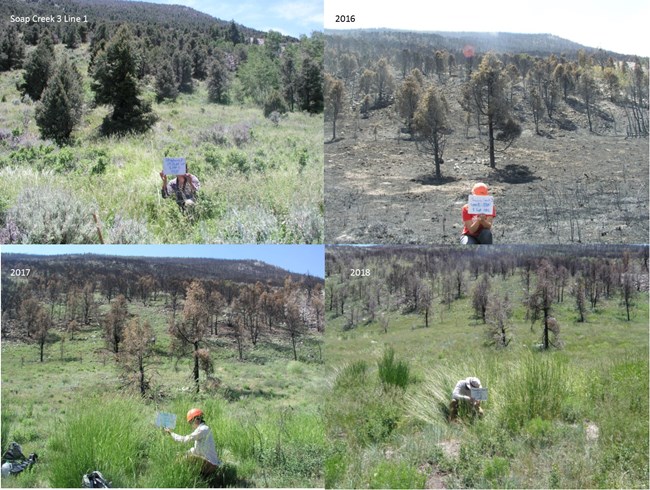Part of a series of articles titled The Midden - Great Basin National Park: Vol. 19, No. 1, Summer 2019.
Article
SNPLMA-Funded Strawberry Creek Restoration Project Complete
This article was originally published in The Midden – Great Basin National Park: Vol. 19, No. 1, Summer 2019.

NPS Photo by Julie Long
The Southern Nevada Public Lands Management Act (SNPLMA)- funded Strawberry Creek Fuels Reduction and Sagebrush Steppe/ Aspen Restoration project has come to a close. Initiated in 2015, this fuels reduction and habitat restoration project included 206 acres of Strawberry Creek.
Project objectives were to restore sagebrush steppe habitat, improve aspen condition, reduce fuel loading, and increase the quality and quantity of habitat for shrub-dependent wildlife species. In August 2016, the lightning-ignited Strawberry Fire burned over the entire project area and refocused our restoration strategy. Since fuels reduction and conifer removal objectives were met by the fire, post-fire restoration focused on revegetation treatments, removing hazard trees, stabilizing slopes and streambanks, and survey and treatment of invasive plants.
The project area was included in two aerial seedings. A total of 307 acres were seeded with a native seed mix. Native shrub, grass and forb species were used in the mix: mountain big sagebrush (Artemesia tridentata), basin wildrye (Leymus cinereus), bluebunch wheatgrass (Pseudoroegneria spicata), Indian ricegrass (Achnetherum hymenoides), redroot buckwheat (Eriogomum racemosum), Palmer’s penstemon (Penstemon palmeri), and arrowleaf balsamroot (Balsamorhiza sagittata).

NPS Photos
Nuisance and hazard trees were removed on 13 acres. Saw crews completed contour felling of burned trees to help stabilize slopes and protect streambanks. One thousand Ponderosa pine (Pinus ponderosa) seedlings were planted on eight acres, and invasive plant surveys were completed on 202 acres. New infestations of houndstongue (Cynoglossum officinale), a Nevada noxious weed, and African mustard (Malcomia africana) were discovered and treated post-fire. Restoration treatments were conducted with a combination of NPS staff, Exotic Plant Management Teams, and Nevada Conservation Corps crews. Thanks to everyone who helped make this project a success!
Note: Strawberry Creek is now open for day-use visitation. Check out the amazing recovery of the area for yourself!
Last updated: February 15, 2024
